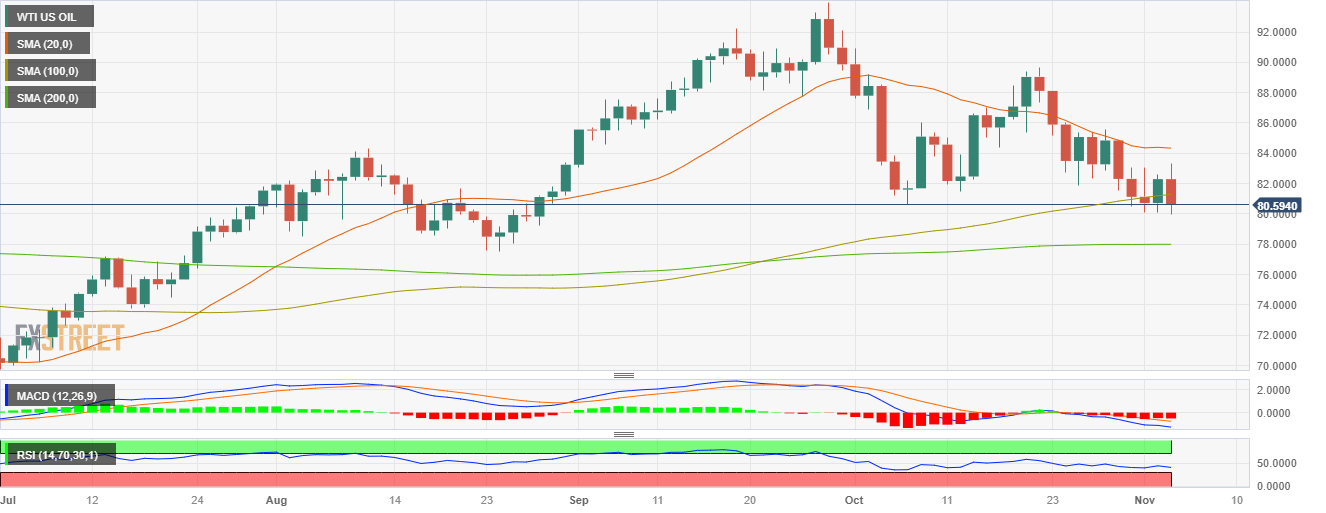- The WTI barrel price declined by more than 2% to $80.70.
- The US reported soft labor market figures.
- Tensions in the Middle East are easing, favouring the price to decline.
At the end of the week, the West Texas Intermediate (WTI) barrel is seeing sharp losses, mainly due to worries on the US economy, the largest Oil consumer, after the release of weak labor and economic activity data. In addition, as the Middle East tensions ease, markets are confident that there won't be any supply or demand disruptions also contributing to the downward movements.
The US Bureau of Labor Statistics revealed disappointing numbers, as job additions for October from the US economy fell short of expectations at 150,000 vs the 180,000 expected and decelerated from its revised previous figure of 297,000. In addition, the Unemployment Rate rose to 3.9%, above the expected 3.8% while the Average Hourly Earnings increased by 0.2% MoM, lower than the projections and tallied a 4.1% YoY increase. In line with that, if the US continues to reveal that its economy is weakening and that the cumulative effects of the monetary policy are kicking in just now, Oil prices could face further downside as lower energy would be demanded from the largest consumer in the world.
On the positive side, as the Federal Reserve (Fed) approaches the end of its tightening cycle, it would be beneficial for the WTI price as higher rates tend to be negatively correlated with energy demand. In that sense, the market focus shifts to the next reports ahead of the next Fed meeting in December, including two additional inflation readings and a job report.
WTI Levels to watch
Upon evaluating the daily chart, a neutral to bearish outlook is seen for the WTI, with the balance starting to lean in favour of the bears, although they still have some work to do.The Relative Strength Index (RSI) has a negative slope below its midline, while the Moving Average Convergence (MACD) displays neutral red bars. In addition, the price has fallen below the 20 and 100-day Simple Moving Averages (SMA), which seem to be converging towards the $83.00 area to perform a bearish cross, which would likely trigger further downside for the WTI in the short term.
Support levels: $80.50, $80.30, $80.00.
Resistance levels: $81.60 (100-day SMA), $82.80, $83.50
WTI Daily Chart

Information on these pages contains forward-looking statements that involve risks and uncertainties. Markets and instruments profiled on this page are for informational purposes only and should not in any way come across as a recommendation to buy or sell in these assets. You should do your own thorough research before making any investment decisions. FXStreet does not in any way guarantee that this information is free from mistakes, errors, or material misstatements. It also does not guarantee that this information is of a timely nature. Investing in Open Markets involves a great deal of risk, including the loss of all or a portion of your investment, as well as emotional distress. All risks, losses and costs associated with investing, including total loss of principal, are your responsibility. The views and opinions expressed in this article are those of the authors and do not necessarily reflect the official policy or position of FXStreet nor its advertisers. The author will not be held responsible for information that is found at the end of links posted on this page.
If not otherwise explicitly mentioned in the body of the article, at the time of writing, the author has no position in any stock mentioned in this article and no business relationship with any company mentioned. The author has not received compensation for writing this article, other than from FXStreet.
FXStreet and the author do not provide personalized recommendations. The author makes no representations as to the accuracy, completeness, or suitability of this information. FXStreet and the author will not be liable for any errors, omissions or any losses, injuries or damages arising from this information and its display or use. Errors and omissions excepted.
The author and FXStreet are not registered investment advisors and nothing in this article is intended to be investment advice.
Recommended content
Editors’ Picks

EUR/USD climbs higher toward 1.1100 ahead of US CPI release
EUR/USD extends its daily rally toward 1.1100 on Thursday as the Euro benefits from the EU's decision to pause countermeasure against US tariffs for 90 days. Meanwhile, the US Dollar remains under pressure ahead of CPI data, further boosting the pair.

GBP/USD rises above 1.2900, US CPI data awaited
GBP/USD preserves its bullish momentum and trades above 1.2900 on Thursday. The British Pound capitalizes on risk appetite, courtesy of Trump's tariff pause, allowing the pair to push higher as market focus shits to March inflation data from the US.

Gold clings to gains above $3,110, closes in on all-time high
Gold builds on Wednesday's impressive gains and trades above $3,110 on Thursday. The broad-based selling pressure surrounding the US Dollar and retreating US bond yields on growing fears of a deepening trade war between China and the US fuel XAU/USD's rally.

US CPI data set to reveal March inflation dip as markets weigh impact of Trump’s tariffs
As measured by the CPI, inflation in the US is set to rise at an annual pace of 2.6% in March, down slightly from the 2.8% reported in February. Core CPI inflation, which excludes the volatile food and energy categories, is expected to ease to 3% in the same period from a year earlier

Trump’s tariff pause sparks rally – What comes next?
Markets staged a dramatic reversal Wednesday, led by a 12% surge in the Nasdaq and strong gains across major indices, following President Trump’s unexpected decision to pause tariff escalation for non-retaliating trade partners.

The Best brokers to trade EUR/USD
SPONSORED Discover the top brokers for trading EUR/USD in 2025. Our list features brokers with competitive spreads, fast execution, and powerful platforms. Whether you're a beginner or an expert, find the right partner to navigate the dynamic Forex market.



